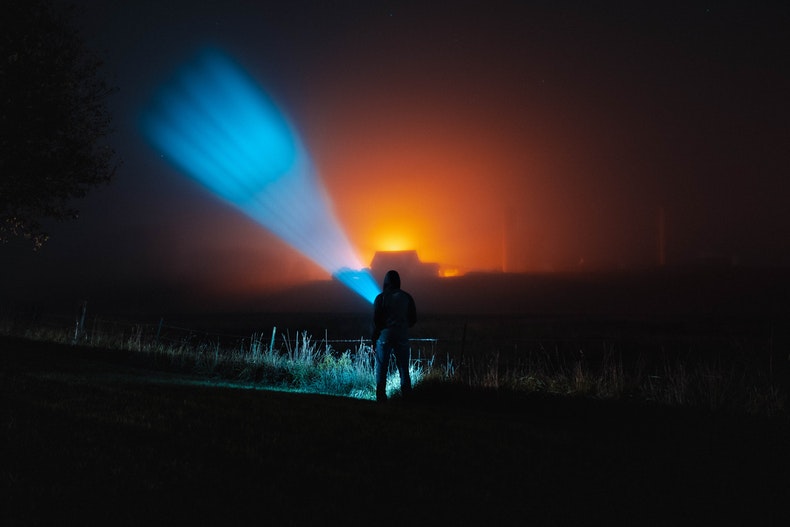NIGHT AND THERMAL VISION IN THE SPACE INDUSTRY.
Night vision devices and thermal vision in modern science.
Is it possible to see anything at night when visibility is limited? There’s one answer to that question: practically anything.
Of course, if you use a night vision device, an optoelectronic device that allows you to do the impossible – to give full “vision” to the observer in complete darkness. The comparative range of measuring instruments is quite long. These are collimator lenses, digital measuring cameras, photometers, spectral equipment, test objects, and so on.
All of this is improving the quality and production of instruments with improved sensitivity, operating at almost zero light levels. This first improve the technical capabilities of special units, enables combat operations at any time of the day or night, and provides leaders of attack groups with necessary and quick information for making adjusted decisions in case of fog, rain, or other adverse weather conditions.
Two types of devices contribute to this effort, night vision, and thermal imaging. Devices with fundamentally different technologies, both in technical properties and principles of use and price. They have one thing in common – without a light source, these devices do not work in complete darkness.
Devices with infrared illumination are an exception since they can illuminate the object of observation. The principle of their work consists of multiple amplification of the captured light. If the human eye can spectrally see up to a certain range, beyond which total darkness begins, the night vision devices prolong this visibility almost several times more. This is influenced by features that are determined by the generation and technology of the device.
From zero to the third generation, including digital. Their quality and possibilities increased with every generation, mainly due to the improvement of the main element of night vision – and electro-optical converter, which is responsible for multiple amplification of light and sharpness of the received picture. This in turn depends on the light amplification factor, photocathode sensitivity, and high resolution.
Almost all generations of the device differ significantly from each other in design, technical characteristics, and cost. By the way, new developments of the device were slowed down due to the high cost of its production. It missed the competing technology – thermal imaging – to the first position. Thermal imager.
Today’s thermal imaging cameras are based on the charge-coupled device on the basis of silicon photodiodes, which allows projecting the signal onto the matrix as a temperature distribution marked in different colors. A device that operates on the principle of examining an object of observation by the temperature distributed over its surface.
It remotely measures the object under study, obtaining as a result of a thermal image in real-time with marked temperature color values, where the cold areas, highlighted in blue and blue, and pictures that are colored in orange and red are responsible for the temperature with high values.
The thermal imaging camera is independent of ambient light. Its application is a rapidly expanding area with unlimited potential. Simply put, it reacts to the radiation from the object towards which the meter is pointed and works perfectly in darkness, dusk, smoke, and fog, in grass and bushes. With this technology device on the thermal signs “will see” people and animals, despite the natural camouflage.
Night vision devices and thermal vision in the space industry.
Night vision has long moved into space. For a long time, western countries have been exploring and studying space, both for scientific purposes and developing military doctrines, allocating huge funds from federal budgets, and attracting money from private commercial entities. Entire aerospace campaigns, solving the complex problems of developing optoelectronic stations for detecting and collecting information about space objects. All this makes it possible to process a huge amount of information
related to space exploration. Through the use of night vision, the work of the complexes is carried out in real-time, day and night, providing reliable information on both known and new objects detected in outer space. For example, scientists developed and implemented night vision equipment, which made it possible to take unique quality photographs at night by using infrared illumination and an infrared motion compensation system.
This innovation made it possible to capture high-quality photographic images with slow shutter speeds without flickering or blurring the frame. The result exceeded expectations: perfect pictures of the observed objects were taken at a speed of ten kilometers in a second and a half. In the absence of sunlight and moonlight, using thin atmospheric air as a light source.
The future of night vision and thermal vision instruments in spaceflight.
“Live in peace, but be prepared for war,” this principle is at the heart of the defensive concept of all developed nations of the world that cherish their independence. Therefore, the high priority on the agenda is the high defense capability of these countries. The entire military-industrial complex, including supersonic aviation, flights of spaceships, satellites, and the like.
On board the supersonic aircraft have already been tested a system of forwarding vision with the use of thermal imagers, which made it possible, to identify and attack ground targets of the enemy from long distances. Computer systems for identifying enemy air and ground targets by thermal de-masking have been operational. Improved night vision goggles with a panoramic field of view and a 100-degree horizontal field of view were tested.
The main feature of these glasses is that they combine two basic technologies of night vision – electro-optical converter and thermal imaging. And of course, what is space without laser weapons of directional energy, transmitting this energy through a laser beam to the target. It looks simple and effective: the target is struck by heat
to the point where it is unable to function. Among the advantages of this weapon, is certainly the propagation of laser beams at the speed of light, which makes targeting much easier. The laser beam propagates in a straight line for hundreds of kilometers, virtually eliminating any maneuvering of the potential target. And, with a constant power source, the laser operates continuously.
The drawbacks include atmospheric effects where the beam can be absorbed, scattering, and turbulence. Also, adverse weather conditions such as rain, fog, and smoke.
Large defense companies are working on this.
Studying the possibility of getting high-quality images of objects on the ground from space, it was proposed to use as a natural “illumination” behind the observed objects the airglow of the Earth, amplified by equipment with infrared wavelengths.
Since during the night the brightness of the atmospheric illumination changes depending on the weather in the lower atmosphere, it was problematic to make high-quality observations in darkness from space and to make photo filming.







